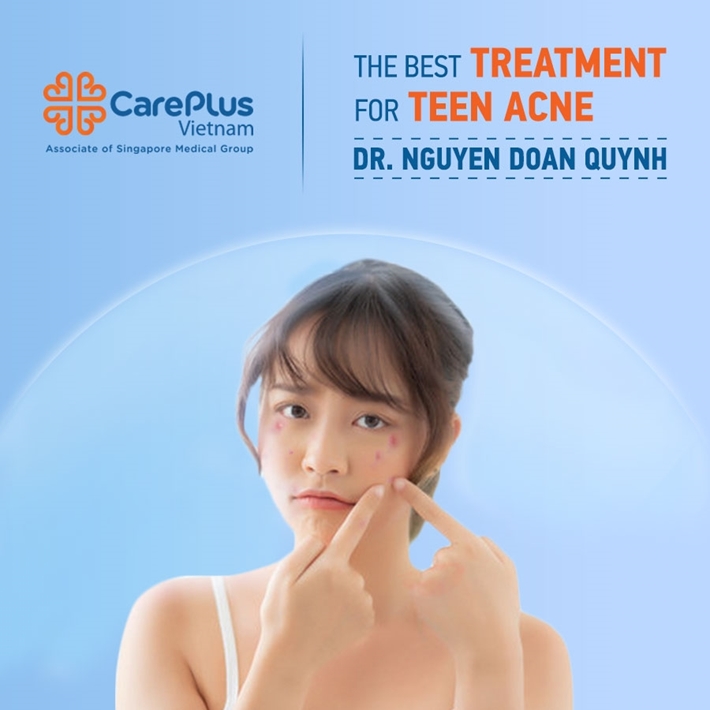The best treatment for teen acne
Acne is probably the most common skin disease. 90% of teenagers have acne, most of which will subside and go away after entering adulthood. However, the new acne stage that appears and begins to aggravate causes many troubles for young people. In particular, there are cases where acne negatively affects children's confidence and psychology.

7/9/2021 3:06:48 PM
1. What causes acne in puberty?
Many factors contribute to the formation of acne, but the first is probably the increase in androgen hormone levels during puberty. During this period (about 8-9 years old), the child's body will undergo major changes silently from the inside to prepare for the gender-specific modifications on the outside. One of them is an increase in the levels of sex-related hormones.
Known as the sex hormone specific for the formation of masculine characteristics, androgen secretion from the adrenal glands is increased in both boys and girls during prepubertal age. This hormone acts on the skin system, increases the production of sebaceous cells, increases the size of the sebaceous glands, and stimulates the glands to increase sebum secretion.
The skin of the face and scalp is where the most hair follicles - sebaceous glands are concentrated in the body (about 400-800 glands/cm in the front compared to 50 glands/cm² in the hands and feet), so this is also where acne occurs. The most fish on the body. In addition to the face, acne during puberty can also appear on the chest and back.
On the other hand, the accumulation of sebum also increases the adhesion of dead cells in the hair follicles, creating conditions for an increase in the concentration of P.acnes bacteria here. When there is no inflammation, this accumulation in the pores of the hair follicles makes whiteheads and blackheads. When this accumulation becomes too much to bear, the hair follicle wall can rupture, releasing the above substances into the surrounding tissue and triggering inflammatory reactions under the skin. By this time, one can observe the acne becoming swollen and red, sometimes containing pus. Acne spots that are reddened and swollen and grow deep into the underlying tissue can create inflammatory, painful cysts and are at risk of scarring.
To summarize, the main factors that form teenage acne are:
- Increased secretion of excess oil in hair follicles
- Accumulation of dead cells in hair follicles
- An increase in P.acnes bacteria in hair follicles
Excess oil, dead cells, and bacteria build-up break down the hair follicle walls, triggering a local inflammatory response.
2. What types of acne are there?
Whiteheads - white, round, not red, swollen, formed due to the accumulation of sebum and dead cells in the hair follicle.
Blackheads – are round, black dots that form due to the accumulation of sebum and dead cells in the hair follicles. These accumulations open up to the skin's surface, oxidized for a long time, and become black.
Inflammatory papules and pustules are red, mildly swollen lesions formed by the blockage of the hair follicle and the rupture of the hair follicle wall near the skin's surface.
Deep cysts - red, pus-filled lesions formed by occlusion of the hair follicle and rupture of the hair follicle wall in the deep layers of the skin.
3. How is juvenile acne treated?
Most cases of acne during puberty are mild, and a topical acne medication is sufficient. These topical medications mainly reduce inflammation and prevent new acne from forming. The effect of the drug does not come immediately but after 2-3 months of continuous treatment. After three months, if the acne does not improve, the child may need more oral medication.
Will usually treat More severe cases, many pustular lesions, inflammatory acne, deep cysts with the risk of scarring from the beginning with oral drugs combined with topical medications. These are drugs that need to be prescribed and should be examined and monitored by a doctor.
4. Some notes in acne skincare at puberty:
✅ Wash your face twice a day to limit the accumulation of excess oil. Choose a mild cleanser. Don't use cleansers containing "exfoliating beads" or use abrasive tools or washcloths to exfoliate, which damage the skin and aggravate inflammation.
In some children, topical acne medication can irritate with the following phenomena: dry skin, red skin, peeling skin. If these occur after applying the medication, your child can apply a thin layer of moisturizer after using the acne medication.
✅ Limit squeezing, squeezing and removing acne. These movements, especially with a dirty hand, will aggravate existing acne and increase the risk of scarring.
🩺 Now, parents can choose to use CarePlus's telehealth service still to take care of their children's puberty health and ensure safety during the complicated epidemic situation. 👉 See more details about telehealth here https://careplusvn.com/vi/kham-tu-van-tu-xa
---
📣📣📣 CarePlus was announced by HCDC and the Department of Health as one of the trusted clinics to perform rapid testing for COVID-19 antigens for people wishing to leave the city. HCM. See details at 👉 https://www.facebook.com/careplusclinicvn/posts/4069526009821427